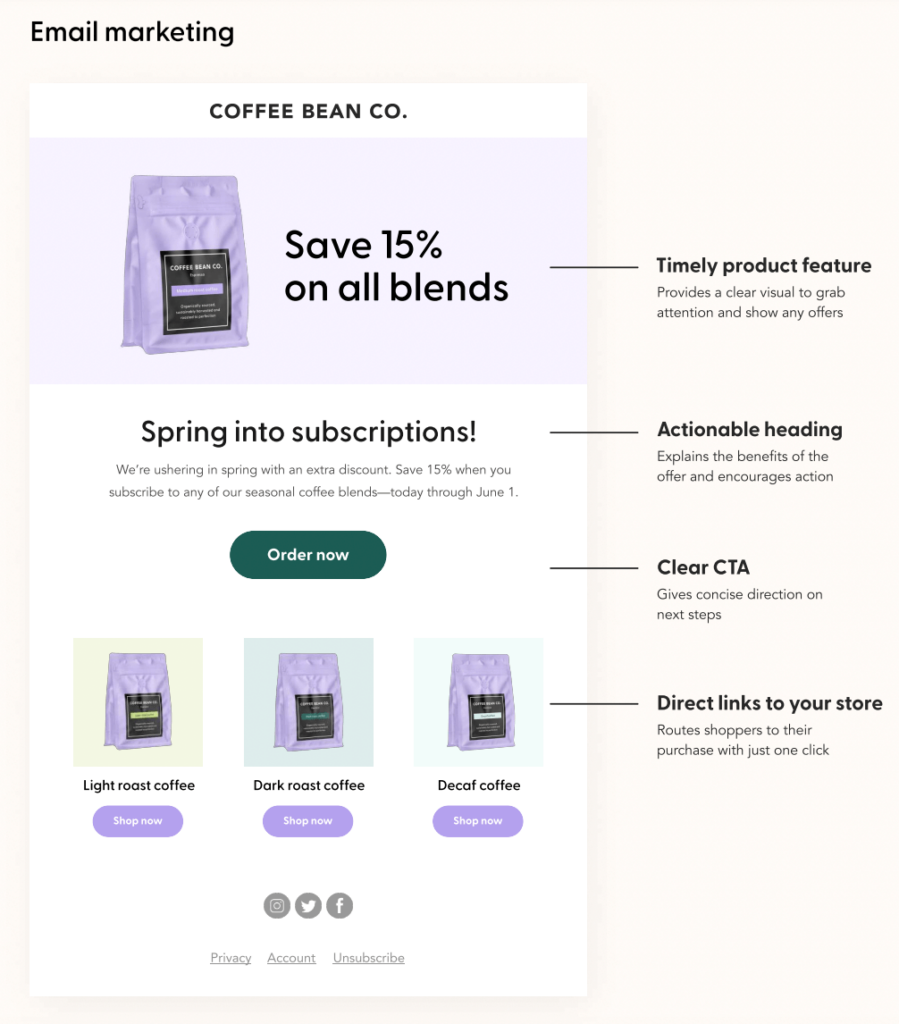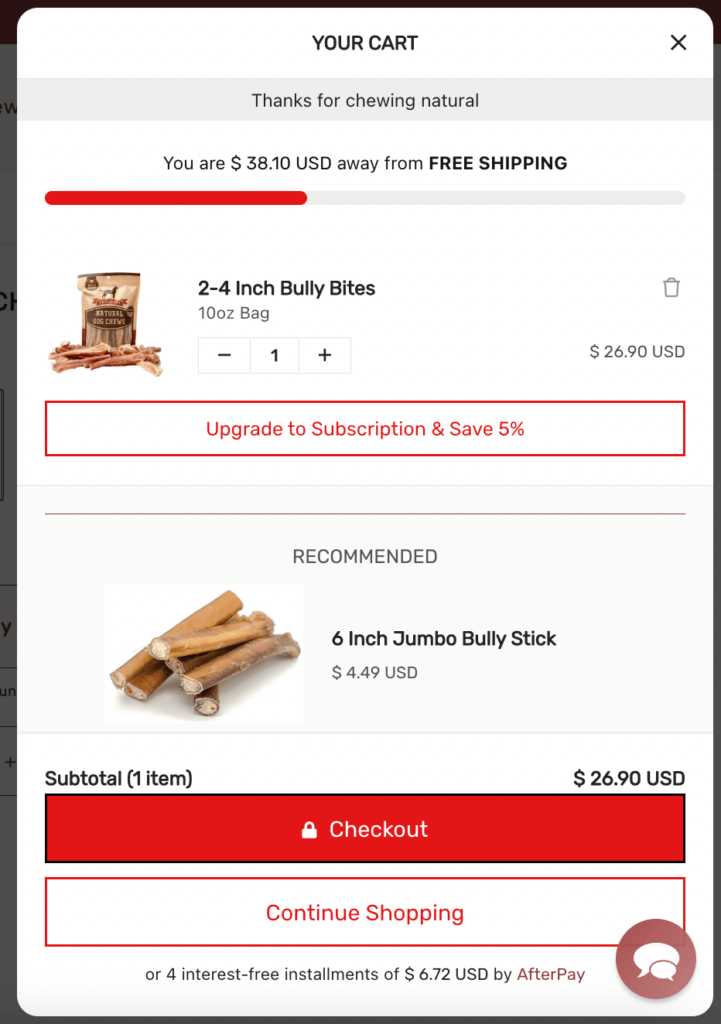Adding subscriptions to your ecommerce store is a powerful business move. As you know, subscriptions can increase your revenue, decrease customer churn, and help you more easily predict your monthly revenue.
But to quickly capitalize on these business-driving benefits, you need to first ensure your customers are aware of your new subscription offerings. To start, leverage these four proven marketing tactics to announce your new subscription offering and drive early subscription sales.
4 key strategies to announce your subscription program & increase sales
1. Promote your subscription offerings through email
When it comes to a digital marketing strategy, email campaigns should be a primary focus for businesses of any size. Tapping into subscribers’ inboxes can drive traffic to your website, and build your brand’s credibility and recognition. Plus, it can increase your sales, create strong customer relationships, and even re-engage inactive customers.
Of course, it’s important to leverage this channel strategically and somewhat sparingly, as you don’t want to email your customers too often and risk a high unsubscribe rate. You do, however, want to email your target audience with valuable product announcements, compelling discounts, and big company news—like the fact that you just added subscriptions to your business model.
Once subscriptions are enabled in your store, it’s the perfect time to send your customers an email letting them know about your new offerings.
Not sure where to begin? A common tactic used by ecommerce brands is to offer a discount in exchange for signing up for emails. Consider implementing a popup on your homepage to capture emails in exchange for a discount.
Details to include in your first subscription email
The primary focus of your initial email should be outlining the benefits of subscriptions. More specifically, how is signing up for a subscription going to improve your customer’s day-to-day? For example, subscriptions offer your customers convenience and predictability. Who doesn’t want to take ‘order toilet paper’ off their monthly to-do list?
As a merchant, you may also want to consider offering a slight discount to incentivize your customers to sign up for a subscription. If you take this route, be sure to make this very clear in your email, as seen in the example below. Again, it’s wonderful that you’re now offering subscriptions, but the primary focus of this email should be specifically outlining how these subscriptions will make your customers’ lives better.
Since the recipients of this email are likely not acquainted with your subscription service, you should also include a high-level overview of your subscription policies to reduce any common misconceptions that could enable a barrier to entry. For example, let your customer know they can easily skip a shipment should they already have enough of your product at home—or tell them that you offer hassle-free returns. Mitigating customer concerns up front is imperative to a strong sales strategy.
Lastly, be sure there are convenient, direct links for your customers to learn more within your email. If you’re telling your customers about a new product, ensure you drive to that product’s landing page within the email. If you’re talking about your subscription policies, point them to the FAQ section on your website to learn more.
Making life easier for your customers should be a top priority. If they have to go searching on your website for the product highlighted in the email, you’ve likely already lost their conversion from prospect to subscriber.

2. Boost brand awareness with organic & paid social media campaigns
Social media is undeniably one of the most powerful sources of scalable connection available to us. Although the landscape has drastically changed, the key platforms in the space have maintained a powerful force for ecommerce merchants, quickly surpassing TV, radio, magazines, and other traditional media platforms for engagement.
With social media, you can spread information about your business in a quick and cost-efficient manner, and potentially reach millions of people with your message. That’s right—the main players, including Instagram, Facebook, Twitter, LinkedIn, and TikTok, are accessed by more than 4 billion users. This makes it extremely important to strategically leverage these channels to connect with your current customers, broaden your reach, and build strong brand awareness.
Organic vs. paid content
Creating an engaging presence and effectively advertising on social media requires a strategy. To get in front of the right people at the right time, there are two types of content that should be at the forefront of your strategy—organic content and paid content.
Simply put, organic content is free content you share on social media, including all posts, stories, and videos. This content can be seen by all of your followers, users who follow specific hashtags you use, and the followers of anyone who shares your post.
Paid content, on the other hand, refers to any social media content that you pay for. This can be a unique post that you create specifically for advertising, or to “boost” to your existing organic content. Paid content is especially important for business pages, and can target audiences outside of your direct following, giving you more reach than simply posting organic content.
Your social media strategy should consist of a combination of organic and paid content. You certainly want to maintain a relationship with your current audience, but with so many brands competing for attention on social media, your organic content may not be enough—even if you have a large following. Paid content gives you the ability to not only tap into potential customers, but also ensure that your current customers are actually seeing what you post.
Create engaging content for your newly launched subscription program
First and foremost, you need to hone in on your social media strategy and determine which social media channels you want to emphasize. Sprout Social’s 2022 social demographics study is a great resource to help you understand the ideal customer profile for each channel, as well as for year-over-year platform growth. For example, 25% of those who use TikTok are under 19 years old, so if this is not your target demographic, you should likely leverage different channels.
Once you understand the appropriate channels to use for your audience, you need to understand the best practices for each channel.
Now that you’re selling subscriptions in your store, it’s a great time to not only announce this update with an engaging social media post, but also to put together a social media strategy and posting cadence that will continuously draw new and existing customers to your business.
3. Focus on your SEO, including specific keywords
SEO stands for search engine optimization. It’s the process of generating organic traffic—via technical SEO or keyword research—from search engine sites like Google, Yahoo, and Bing. Because succeeding in business is dependent on consumers being able to find your online store, SEO is crucial for any ecommerce business that wants to successfully market its products or services.
Top keywords to leverage for any subscription business
Most pieces of content for your ecommerce site should start with keyword research. One way to identify the proper keywords is to think about the Google search your customers will make, the questions they have, and what they might search for when looking for your product or services online.
Product pages, blogs, and landing pages can all be optimized to include important keywords, making them more popular on Google. This type of on-page SEO for ecommerce is crucial for getting the search results you want. That said, how do you determine which keywords will warrant the best results for your business?
Every ecommerce website should utilize tools like Google Analytics, Ahrefs, and Surfer as part of their SEO strategy. However, to help kickstart your SEO journey, we’ve consolidated some top keywords for subscription businesses:
- (Product type) gift box
- (Product type) subscription box
- (Product type) box
- (Product type) subscription
4. Update your website to promote your new subscription option
Once you successfully drive subscription demand to your website, you need to ensure your website is optimized for converting one-time purchasers into subscribers. To maximize your business benefits, including increased revenue, decreased business expenses, and more seamless revenue prediction, focus on increasing your ratio of subscribers to one-time purchasers.
So—how can you accomplish this? To start, implement these four simple, yet essential website best practices.
Centralize critical information for your subscription program
Create a dedicated subscription landing page to consolidate information on topics like subscriber perks, cancellation policies, and logistics. Customers can be hesitant to subscribe before they know exactly what they’re committing to, so providing answers to common subscription questions can build trust and confidence with your customers through transparency.
Highlight your subscription offering on your store’s homepage
You can draw attention to your subscription program on your homepage with a simple banner, call-to-action button, or, if resources permit, a landing page redesign. This makes it easy for your customers to discover your subscription program and quickly understand the perks of subscribing.
Reduce friction from the product page
To build an effective PDP, you should offer both a subscription and a one-time purchase option—making the former the default option, and creating a custom modal to reinforce the value of subscriptions. Additionally, you should always link back to your subscription landing page to maximize the value of your PDP.
One-click upsell one-time-purchases (OTPs) to a subscription while in cart
A cart upsell modal reminds one-time customers of exactly what they’re missing before they finalize their decision. You can build your own or leverage a paid integration like Rebuy to launch the modal for you.

Develop a strategy for your subscription business
With so many ways to drive demand for your business, it’s important to stay focused and adhere to your strategy. Before implementing any of the above marketing tactics, be sure to take a step back and develop a solid action plan. This will not only help you target the right customers with relevant content, but it will also define how you, as a brand, present yourself to your customers.
Whichever strategies you choose to implement, you can rest assured knowing that your subscription offerings will enhance the customer experience, giving your subscribers another reason to remain loyal and become an advocate for your brand.



